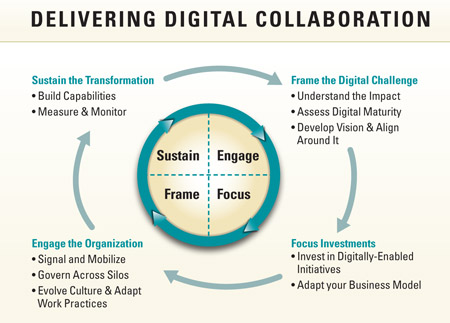Digital Collaboration
 Today’s digital channels have and will continue to fundamentally transform the consumer experience, creating a new class of more informed and more demanding shoppers. As a result, we are also now seeing a blurring of the traditional lines between trading partners, where the “war for the consumer” may actually be yielding to a truer form of collaboration than we’ve ever seen.
Today’s digital channels have and will continue to fundamentally transform the consumer experience, creating a new class of more informed and more demanding shoppers. As a result, we are also now seeing a blurring of the traditional lines between trading partners, where the “war for the consumer” may actually be yielding to a truer form of collaboration than we’ve ever seen.Suppliers and retailers are now beginning to work together using a variety of tools with ever increasing degrees of sophistication in the world of social media, digital marketing and mobile-enabled, direct-to-consumer promotion.
And, in interesting ways we are only beginning to observe, “collaboration” as we’ve known it through such typical core processes as Category, Trade and Supply Chain Management — processes we have spent the last 20 years building and honing — may just be moving to a far more dynamic and empowering opportunity for both parties to work together.
Let’s start with the consumer. With ready access to a broad cross section of detailed product efficacy and pricing information today’s shopper can buy virtually anything, anytime. In addition, social media networks, including Facebook, Twitter, Pinterest, MySpace, Etsy, Tumbler, Instagram, etc., have created a shift in who can talk to whom, when and where, whether B:C or C:C. This has empowered consumers to engage with their favorite brands while sharing information about their experiences, good and bad, with one another. Shoppers can opt-in or out to personalized recommendations tailored to their likes and interests, instantaneously looking up product information and completing a purchase, at their desktop, with an iPad or from their mobile phone. And the degree to which they do so while never a guarantee of loyalty holds the key to exactly that.

Given this new found consumer power in a digital world, the roles of retailers and their suppliers are evolving. And that evolution is complicating the relationship for some trading partners. As an example, manufacturers like P&G are now engaging customers directly through brand specific sites such as Pampers.com, while retailers like Target are simultaneously going on-line and pressing suppliers for unique products to offset “showrooming”. Despite these shifting roles trading partners still share a common interest in the products they sell and the customer/consumer experiences they create. The key question to ask is just how partners can work together in addressing the common goal of brand growth while serving consumer needs? The answer might be found in the shared work of Digital Transformation.
While some trading partners may still think and behave as if Digital Transformation is a “them versus us” pursuit, transformation does not need to be a zero-sum game. Rather than be bound by traditional value chain roles, innovative companies are looking for meaningful opportunities to collaborate as consumers demand a more engaging, convenient and rewarding experience.
Digital Collaboration, as a term, will therefore become a defining feature for leading-edge CPG and retail companies much the way ECR defined the work of Category Management, Trade Promotion Management and New Product Introductions nearly 20 years ago. As such, manufacturers and retailers will need to adopt approaches and processes that support, and dynamically shape, not just the products that are invented, but how consumers truly experience them in a virtual world.
Today, manufacturers and retailers own only pieces of the digital world. The digital journey of the future will be a seamless and consistent, end-to-end multichannel, four-way conversation; Retailer:Consumer, Manufacturer:Consumer, Manufacturer:Retailer and Consumer:Consumer. At any point in this lifecycle, trading partners will access a vast trove of information which when used properly and in a timely manner will have the ability to shift consumer behavior using new-age media techniques not available in the old-age media world.
Delivering on the big idea of a digital partnership will not be unlike many such transformational projects over the years, but with some unique challenges. To get started we might consider the following:
- Frame the Challenge – One of the biggest challenges to digital collaboration is defining what matters to both parties at the start. It is important to take time early in the initiative to align on the strategic goals for collaboration. Each partner needs to understand the relative “digital maturity” of the other, including people, process and technology capabilities. From here partners will want to define a shared vision of the consumer experience, including how each will support it.
- Focus on Investments – Rather than invest in every opportunity, partners should identify those which can demonstrate early success, generate momentum within each organization and deliver tangible business value. Recognizing the contributions of each party to the effort and understanding how each will realize the “win-win” explicit to every collaborative effort will also ensure the partnership’s viability and success.
- Engage Your Organizations – Collaborating across digital channels will require new processes, skills and ways of working together. Much like Category and Trade Promotion Management, agreements will need to be made defining areas of shared interest as well as those best managed by individual parties.
- Sustain the Transformation – Assume and plan for consumer expectations to evolve at least as fast as your transformation. Collaboration partners must continue to invest in new skills and explore new opportunities on the periphery, measuring and monitoring progress against the goals of the partnership, and building a shared cadence and culture around new digital measures of success.
